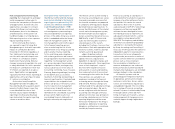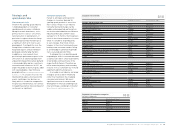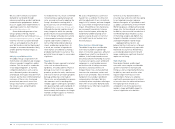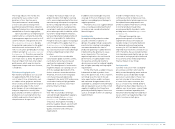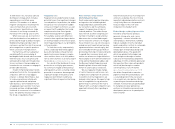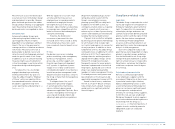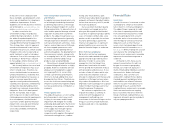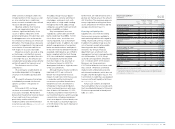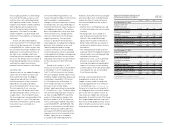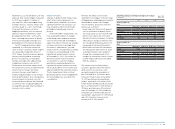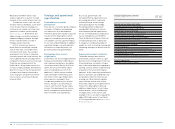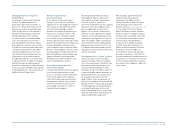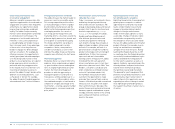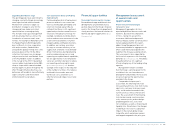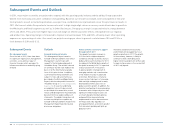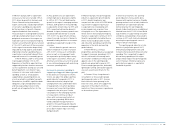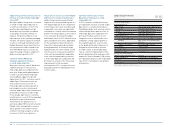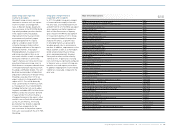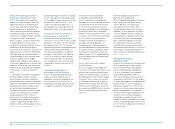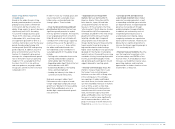Reebok 2010 Annual Report Download - page 174
Download and view the complete annual report
Please find page 174 of the 2010 Reebok annual report below. You can navigate through the pages in the report by either clicking on the pages listed below, or by using the keyword search tool below to find specific information within the annual report.
170 Group Management Report – Financial Review Risk and Opportunity Report
We believe the IFRS 7 interest rate
analysis represents a realistic if rough
estimate of our current interest rate risk.
To moderate interest rate risks and
maintain financial flexibility, a core tenet
of our Group’s financial strategy is to
continue to use surplus cash flow from
operations to reduce net borrowings
see Treasury, p.146. Beyond that, the
adidas Group is constantly looking for
adequate hedging strategies through
interest rate derivatives in order to
mitigate interest rate risks.
In 2010, interest rate levels in
North America and Europe reached
new all-time lows. In the light of the
low interest rate levels, the easing of
government fiscal action to stimulate
economic growth and rising inflation, the
risk of upward interest rate adjustments
compared to the prior year has increased.
Therefore, we now believe that the
likelihood of a Group-wide interest rate
increase is highly probable. Nevertheless,
given the increase in our Group’s portion
of longer-term fixed rate financing in
2010, we project any potential interest
rate increases as having a moderate
financial effect.
Strategic and operational
opportunities
Favourable macroeconomic
developments
Since we are a consumer goods company,
consumer confidence and spending
can impact our sales development.
Therefore, better than initially forecasted
macroeconomic developments which
support increased discretionary private
consumption can have a positive impact
on our sales and profitability. In addition,
legislative changes, e.g. with regard to
the taxation of corporate profits, can
positively impact Group profitability.
Growing importance of sports
to fight obesity
Governments are increasingly promoting
living an active lifestyle to fight obesity
and cardiovascular disease. According
to the International Obesity Task Force
(IOTF), more than 600 million adults
were considered obese in 2010. An
additional 1.0 billion were estimated
to be overweight. Furthermore, up to
200 million school-age children were
either obese or overweight. Once
considered a problem only in affluent
nations, obesity is also becoming an
issue in countries with low per capita
income. This development has serious
health consequences and a dramatic
effect on health care expenditures.
As a result, governments and
non-governmental organisations are
increasing their efforts to promote
a healthy lifestyle and encourage
sports participation. For example,
the US Department of Education
awarded US $ 80 million to schools
and community-based organisations
for use in innovative physical education
classes through the Carol M. White
Physical Education Program. Given our
strong market position, in particular
in categories considered suitable for
weight loss such as training, running and
swimming, we expect to benefit from this
trend.
Ongoing fusion of sport and lifestyle
The border between pure athletics
and lifestyle continues to blur as sport
becomes a more integral part in the lives
of more and more consumers. People
want to be fashionable when engaging in
sporting activities without compromising
on quality or the latest technological
advances. At the same time, performance
features and styles are finding their way
into products meant for more leisure-
oriented use. We estimate the global
sports lifestyle market to be at least
three times larger than the performance
market. This development opens up
additional opportunities for our Group
and our brands – which already enjoy
strong positions in this market. One
example of this is our plan to expand the
adidas NEO label as part of our Route
2015 strategic business plan see Global
Brands Strategy, p. 87.
Corporate opportunities overview
Strategic and operational opportunities
Favourable macroeconomic developments
Growing importance of sports to fight obesity
Ongoing fusion of sport and lifestyle
Emerging markets as long-term growth drivers
Women’s segment offers long-term potential
Increasing consumer demand for functional apparel
Growing popularity of "green" products
Social media offering new ways of consumer engagement
Strong market positions worldwide
Multi-brand approach
Personalisation and customisation replacing mass wear
Exploiting potential of new and fast-growing sports categories
Expanding distribution scope
Cost optimisation drives profitability improvements
Financial opportunities
Favourable financial market changes
07


